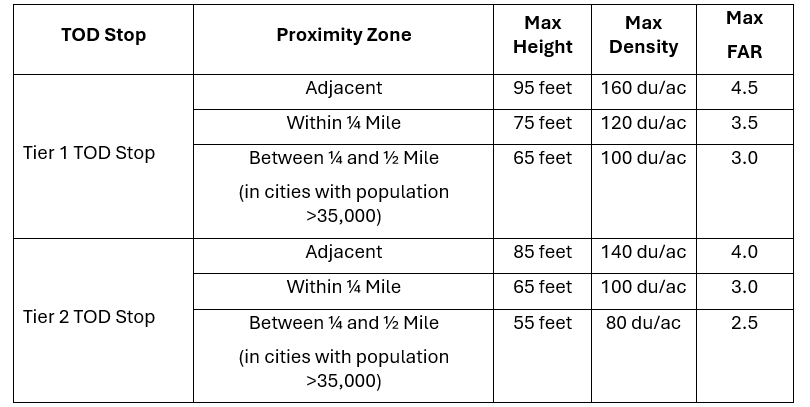SB 79—Transformative Upzoning Near Transit in California
On October 10, 2025, Governor Gavin Newsom signed , authored by Senator Scott Wiener and others, into law. SB 79 represents a significant step in California’s ongoing efforts to address the housing crisis by upzoning properties near qualifying transit stations in urban counties. The bill’s provisions take effect in incorporated cities on July 1, 2026, and require local agencies to permit housing developments of up to 95 feet in height and up to 160 dwelling units per acre (or more, with density bonuses or alternative zoning). This is regardless of the local agency’s underlying zoning and development standards. SB 79 may be one of the most significant examples of state authority trumping local agency control over municipal planning.
Scope of SB 79
SB 79 amends the California Government Code to add new Chapter 4.1.5, Transit Oriented Development, commencing with Section 65912.155. The bill’s core provisions require that housing development projects within specified distances of transit-oriented development (TOD) stops be permitted uses on any site zoned for residential, mixed use or commercial development. Further, SB 79 mandates that housing developments be permitted up to the maximum height, density and floor area ratios prescribed by the bill.
Key Provisions
Tiered TOD Stops: SB 79 establishes two tiers of TOD stops—Tier 1 stops, which serve heavy rail or very high frequency commuter rail in urban counties, and Tier 2 stops, which serve light rail, high-frequency commuter rail or qualifying rapid bus service. SB 79’s mandated upzoning is more significant near Tier 1 stops.
Proximity Zones: The maximum height, density and floor area ratios permitted under SB 79 are determined by the proximity of a property to a Tier 1 or Tier 2 stop. These proximity zones include (1) properties adjacent to the stop; (2) properties within ¼ mile of the stop; and (3) for cities with a population greater than 35,000, properties between ¼ and ½ mile of the stop. Within these proximity zones, housing developments shall be a permitted use on all property zoned for residential, mixed use and commercial uses, and shall be permitted up to the following specified heights, densities and Floor Area Ratio (FAR), regardless of current development standards that may preclude such height, density or FAR:
MAXIMUM DEVELOPMENT STANDARDS UNDER SB 79

Project Requirements: To benefit from SB 79’s provisions, housing developments must:
- Include at least five dwelling units;
- Meet minimum density standards of at least 30 dwelling units per acre or the minimum required by the local agency, whichever is greater;
- Include a minimum percentage of affordable housing units
- Have an average unit size no greater than 1,750 square feet of net habitable area;
- Include either seven percent extremely low-income units, ten percent very low-income units or 13 percent lower-income units; and
- Comply with local demolition/anti-displacement ordinances and inclusionary zoning, provided such requirements do not preclude SB 79’s standards.
Municipal Ordinances: Cities may adopt ordinances to align local zoning with SB 79, including objective standards, provided these do not physically preclude the maximum development allowed under SB 79. Such ordinances are statutorily exempt from CEQA review. The California Department of Housing and Community Development (HCD) reviews these ordinances for compliance with SB 79.
Local Exemptions and Alternative Plans: SB 79 does provide local agencies with the option of adopting an “alternative plan” which can exempt certain properties—such as those containing a designated historic resource—so long as the overall alternative plan’s total net zoned capacity is the same as that permitted under SB 79.
MPO Mapping: SB 79 directs California’s Metropolitan Planning Organizations to map all Tier 1 and Tier 2 stops and proximity zones within their jurisdiction. SB 79 provides that stops and zones shown on such maps carry a rebuttable presumption of validity for project applicants and local governments. SB 79 does not set a deadline by which these maps must be prepared and published.
Transit Agency Zoning Powers: SB 79 authorizes transit agencies to adopt their own zoning standards for agency-owned property near Tier 1 and Tier 2 stops, provided projects dedicate at least 50 percent of square footage to residential use and 20 percent of units to affordable housing.
Implications for Land Use and Development
SB 79 could dramatically increase housing capacity near transit in California’s urban counties. By overriding local zoning restrictions and streamlining approval for high-density residential projects, the bill aims to promote TOD and address the state’s acute housing shortage. Local governments retain some flexibility to tailor implementation through ordinances and alternative plans but must maintain overall housing capacity and comply with HCD oversight. But even with alternative plans, local agencies are significantly limited in their ability to reduce the heights and densities of the housing developments encouraged by this bill, let alone deny or disapprove them.
Next Steps
SB 79's provisions are complex. If you have questions regarding how SB 79 may affect your land development project or local planning efforts, please reach out to Jennifer Lynch or your relationship partner.
